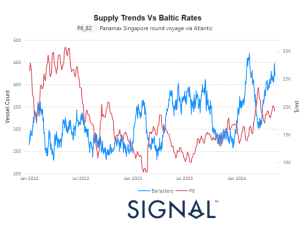The world’s staple grains swung wildly, after hitting multiyear highs as Russia’s invasion Ukraine stifles shipments from some of the biggest suppliers.
Wheat futures rocketed past $10 a bushel for the first time in more than a decade. Corn leaped to a nine-year high before paring gains, and soybean oil edged down from a record. The high prices are giving fresh impetus to accelerating global food inflation, and the turmoil unleashed by the war has the potential to dislocate markets for years to come.
The supply disruptions are likely to spill over into the next season, and potentially for even longer. Ukrainian farmers—many engaged in the defense of their country—appear unlikely to plant spring crops as usual, and Russia is facing sweeping penalties on its financial system. Plus, infrastructure is being damaged in the midst of the war.
“The market is pricing in lost trade coming from the Black Sea region,” Arlan Suderman, chief commodities economist at StoneX, said in a note. “But it hasn’t yet started to factor in a year of lost production from Ukraine.”
Benchmark soft red winter wheat futures jumped by the daily limit for a third straight session in Chicago, soaring as much as 7.6% to $10.59 a bushed. The price has surged more than 30% this year, increasing the cost of everything from bread to cakes and noodles. Milling wheat climbed as much as 9.1% to a record in Paris, before paring gains to about 2%.
Corn—which feeds the world’s hog and chicken herds—rallied as much as 3% to $7.4775 a bushel, the highest since 2012. It last traded little changed. Prices rose by the exchange limit on Tuesday.
Crop prices had already been climbing on tight supplies after harvest setbacks and labor shortages. The rally in recent weeks may be enough to send global food costs to a record when the United Nations publishes its latest price index on Thursday.
Russia and Ukraine account for about a quarter of global wheat and barley trade, a fifth of corn and the bulk of sunflower oil. The invasion and ensuing sweeping sanctions from the U.S. and Europe have sent the grain markets into turmoil, with importers looking to other countries for supplies.

Port activity in Ukraine has been at a standstill since the Russian invasion last week, and grains trade with Russia is also effectively on pause. Traders such as Bunge Ltd. and Archer-Daniels-Midland Co. have shuttered facilities in the region.
Kernel Holding SA, a major Ukrainian agribusiness, said hundreds of its employees have mobilized to the national military and two have died. All processing, exports and logistics are suspended. Posco International evacuated most staff at its Ukraine export terminal.
Ukraine accounts for around half of global sunflower oil exports, and is scheduled to seed the crop in April and May. That’s around the same time as corn, part of the nation’s spring planting campaign.
With citizens drafted into the army, and transport and logistics in chaos, planting prospects are likely to be upended. Wheat and barley were sown before winter, but questions also loom on how much can be collected.
Global grain stockpiles were already poised for a fifth straight decline. Plus, major import regions like North Africa are expecting smaller 2022 harvests of their own as drought grips the region.
“The crisis is not only threatening Ukrainian sovereignty, but is also extending its reach to the food security of nations already under pressure from soaring food prices,” U.K.-based CRM AgriCommodities said in a note.










